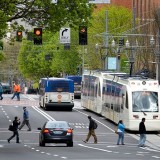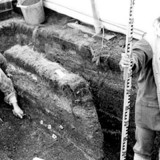There are many instances I’ve come across in the past number of years which suggest to me the Campbell/Clark Government places no real value on the lives of its citizens – this despite Premier Clark’s “families first” motto.
That’s a bold claim, I know – which is why I’m going to state my case here, drawing on several specific and egregious exhibits. I will not pretend to be detached – for me, the subject matter at hand could not be more personal.
Exhibit A I touched on in a piece last week about the South Fraser Perimeter Road. Amongst the 2,000-plus page documents for the proposed truck highway submitted in 2006 by the Ministry of Transportation – under the direction of then-Minister Kevin Falcon – is the acknowledgement that air pollution from the SFPR would result in increased human illness. The route passes within 500 meters of up to 16 schools in Delta and Surrey, many of them elementary-level, where young children stand to bear the brunt of these health impacts.
The document went on to find a silver lining in all this anticipated misery (this little gem is courtesy of the Delta citizen who actually read all 2,000-plus pages of the submission, Mr. Don Hunt):
“With increased air pollution there can possibly be increased employment (e.g., in the health sector) because of the economic activity associated with correcting the results of its impacts.” (Technical Volume 16, page 39)
I bring this up again – as I have on several occasions in videos and articles over the past four years – because: a) it is just so damned outrageous; b) I believe it epitomizes an attitude that pervades this Campbell/Clark Liberal regime (the above are the words of a civil servant, but it’s the minister and his government with whom the buck stops – it is they who established the culture from which this appalling thinking sprang and who ultimately signed off on its inclusion in the document).
I also bring it up again because, to my knowledge, it has been published only once int he mainstream media – in an article by the Province’s Brian Lewis in 2007.
Exhibit B also involves then-Minister of Transportation Kevin Falcon (if I leave the impression here that I don’t much care for this man, it’s only because I don’t).
Also back in 2006-2007, Mr. Falcon and his ministry went further beyond the pale in events and statements surrounding the protest of a highway through a unique and sensitive ecosystem at Eagleridge Bluffs in West Vancouver. While dozens of citizens, including a number of grandmothers such as the tireless Betty Krawczyk, were being dragged off to jail and threatened with absurd charges of criminal contempt of court by the corporate lawyers of an American construction giant, Peter Kiewett, Mr. Falcon made the following statement at a meeting of the Lower Mainland Municipal Association:
“The Chinese don’t have the labour or environmental restrictions we do. It’s not like they have to do community consultations. They just say ‘we’re building a bridge’ and they move everyone out of there and get going within two weeks. Could you imagine if we could build like that?”
(The answer to Mr. Falcon’s question is Yes, with surprising ease).
This apparently drew chuckles, as it was, of course, said only in jest. I’m sure the Eagle Ridge protesters found it hilarious.
Working as a corporate video producer at the time, I became increasingly disturbed by what I was hearing out of Eagle Ridge – which finally prompted me to take my camera out to West Vancouver and spend several days in the yet-to-be-destroyed forest with some of the brave souls who sacrificed and risked so much to protect that magical place from unnecessary destruction (they were pushing for a tunnel route under the ridge, backed by some of the world’s top transportation engineers as a safer, cheaper, far more environmentally acceptable alternative to the overland route).
What followed was one of the saddest incidents I’ve witnessed, frankly, in my life.
I was in court the day Squamish First Nation elder and protestor Harriet Nahanee stood up to Madame Justice Brenda Brown and informed her that her court had no jurisdiction over Ms. Nahanee or her unceded ancestral territory, upon which she was protesting its wanton destruction.
Shortly thereafter, Madame Justice Brown sentenced a frail 71-year old Ms. Nahanee to two weeks in jail for contempt of court. Ms. Nahanee’s counsel and physician warned against incarceration for health reasons, but their pleas were ignored.
Once jailed at Surrey Pre-Trial Centre, Ms. Nahanee quickly contracted pneumonia and died a week later, after being belatedly evacuated to St. Paul’s Hospital.
I want to be clear that I cannot publicly impugn the court – for legal reasons, but even more so because I take the big-picture view. Everything about that highway and the conflict that arose from it stemmed from this Provincial Government – and that is where the blame lies.
Reflecting back today on these events from five years ago which first drew me into the world of environmental politics in BC and irrevocably changed my life, I think that more than the environmental destruction, it was the sheer indecency of the situation that boiled my blood. It was the skulduggery of a callous, even immoral government that compelled me to start putting my talents to better use.
Finally, for Exhibit C, we return to the town of Tsawwassen in Delta – perhaps this government’s favourite of all punching bags. These fine people have been subjected to so much crap over the years, it’s a wonder they keep soldiering on the way they do. In keeping with my theme of this government not valuing the lives of its citizens, I must raise the battle over high voltage power lines through Tsawwassen that culminated in the summer of 2008.
The community was concerned about the health risks associated with the electromagnetic radiation (EMF) that would emanate from new high-voltage power lines set to pass right through the backyards of some 150 homes and over the grounds of the local high school. All they asked was for the government to properly bury and shield the lines – a far safer method, one which studies they paid significant sums of their own money to retain showed would be very comparable in cost to the overhead method.
There is much debate about EMF, which is why these citizens were calling for the Precautionary Principle to be applied (now that the World Health Organization has recognized EMF as a 2b possible carcinogen in a recent landmark report, there is even less scientific doubt as to the legitimacy of these concerns).
Some 2,500 citizens from this small community gathered one weekend at the high school to demand the government bury the lines. Among the expert speakers and community leaders they heard from was the head of Childhood Leukemia at Children’s Hospital, Dr. Jason Ford. Here’s what he told the crowd:
“Since this whole power line issue has come up in Tsawwassen I’ve had a lot of questions from people here, ‘Are my children going to be at risk?’ And I have to tell you that I don’t know – and the sad thing is that nobody really knows. This is an area of great controversy and intense research in the medical field…And the safe thing, when you don’t know, is to bury the lines.”
In the heat of the public backlash during that intense summer, Gordon Campbell summed up in a television interview his decision to ignore the community’s request – with the cold-eyed precision of a Swiss banker:
“The BC Utilities Commission said that we have to do what’s most cost-effective, so they are going ahead with that line.”
Most cost-effective. That’s it. Sorry, ma’am, we would have saved little Billy from cancer but the bean counters couldn’t make the business case.
Under no circumstances would this excuse pass muster with any reasonable, moral person – even if it were true…But it wasn’t.
First, Campbell pretended as though the BCUC and the BC Transmission Corporation building the lines weren’t already doing exactly what they were directed to do by him. Second, it didn’t prove to be more cost-effective – not by a long shot.
Taxpayers’ dollars were first used to spy on, intimidate, and harass though the courts women and children of the families who spoke out loudest against the lines. An expensive offensive was waged against them involving camera crews, police, helicopters, lawyers, round-the-clock work crews on overtime and a massive public relations effort.
And in the end, the government bought up many of the houses affected by the lines from families driven from their neighbourhoods of many years and flipped them at a loss of tens of millions of taxpayers’ dollars to new families willing to take the risks or oblivious to them.
There was nothing cost-effective about the program. Nor was there anything humane or moral about the way Premier Campbell behaved.
Of course, a very similar issue of electromagnetic radiation connected to new BC Hydro equipment has reared its head of late – that being the “smart” meters now provoking widespread public outrage.
Once again this government and BC Hydro are playing fast and loose with the available science and the health of British Columbians. Energy Minister Rich Coleman recently brushed off citizens’ concerns with the following claim: “The smart meters are outside the home, and their emissions are one hundredth the power of a cell phone. If you stand next to the meter for 20 years, the radiation is the same as a 30-minute cell phone call.” This is all post-WHO report acknowledging the serious cancer concerns with EMF…But we’ll deal more with “smart” meters in subsequent columns.
I’m sure many of you have other worthy examples to add to the above list, from Bill 30 to Fish Lake, our appalling record on child poverty, mental health care, the Downtown Eastside – take your pick. Feel free to share them in our comments section and we’ll compare notes.
I therefore rest my case for now and leave it to readers to judge for themselves whether this gang deserves the privilege and responsibility of serving the people of BC for another term.
There is no doubt in my mind the Campbell/Clark Liberals care very much about your vote – just not the person casting it.





